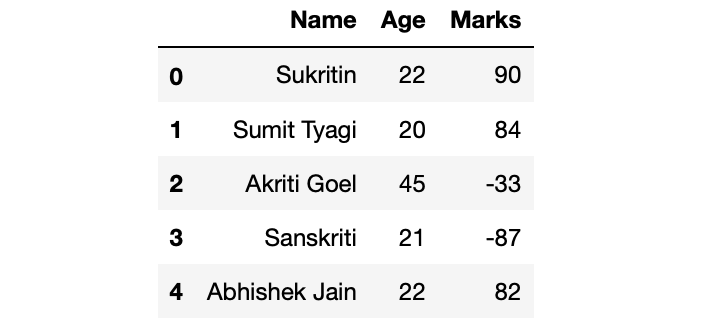Highlight the negative values red and positive values black in Pandas Dataframe
Last Updated :
20 Aug, 2020
Let’s see various methods to Highlight the positive values red and negative values black in Pandas Dataframe.
First, Let’s make a Dataframe:
Python3
import pandas as pd
import numpy as np
dict = {
'Name': ['Sukritin', 'Sumit Tyagi',
'Akriti Goel', 'Sanskriti',
'Abhishek Jain'],
'Age': [22, 20, 45, 21, 22],
'Marks': [90, 84, -33, -87, 82]
}
df = pd.DataFrame(dict)
print(df)
|
Output:

Now, come to the highlighting part. Our objective is to highlight negative values red and positive values black.
Method 1: Using Dataframe.style.apply().
Syntax: DataFrame.style.apply(self, func, axis=0, subset=None, **kwargs)
Parameters:
- func: It should take a pandas.Series or pandas.DataFrame based on the axis and should return an object with the same shape.
- axis: {0 or ‘index’, 1 or ‘columns’, None}, default 0. Apply to each column (axis=0 or ‘index’), to each row (axis=1 or ‘columns’), or to the entire DataFrame at once with axis=None.
- subset: Set of columns or rows on which you want to call the func.
- **kwargs: Pass along to func.
Returns: Styler object.
Example 1: Highlighting text.
Python3
def highlight_max(s):
if s.dtype == np.object:
is_neg = [False for _ in range(s.shape[0])]
else:
is_neg = s < 0
return ['color: red;' if cell else 'color:black'
for cell in is_neg]
df.style.apply(highlight_max)
|
Output:

Example 2: Highlighting cells instead of text.
Python3
def highlight_max(s):
if s.dtype == np.object:
is_neg = [False for _ in range(s.shape[0])]
else:
is_neg = s < 0
return ['background: red; color:white'
if cell else 'background:black; color:white'
for cell in is_neg]
df.style.apply(highlight_max)
|
Output:

Method 2: Using dataframe.style.applymap() method.
Syntax: DataFrame.style.applymap(self, func, subset=None, **kwargs)
Parameters:
- func: It takes a scalar value and return the scalar values
- subset: Set of columns or rows on which you want to call the func.
- **kwargs: Pass along to func.
Returns: Styler object.
Example 1: Highlighting text.
Python3
def highlight_max(cell):
if type(cell) != str and cell < 0 :
return 'color: red'
else:
return 'color: black'
df.style.applymap(highlight_max)
|
Output:

Example 2: Highlighting cells instead of text.
Python3
def highlight_max(cell):
if type(cell) != str and cell < 0 :
return 'background: red; color:black'
else:
return 'background: black; color: white'
df.style.applymap(highlight_max)
|
Output:

Note: pandas.DataFrame.applymap() method passes only single cell into the callable function while the pandas.DataFrame.apply() passes the pandas.Series to the callable function.
Reference: Styling in Pandas
Like Article
Suggest improvement
Share your thoughts in the comments
Please Login to comment...